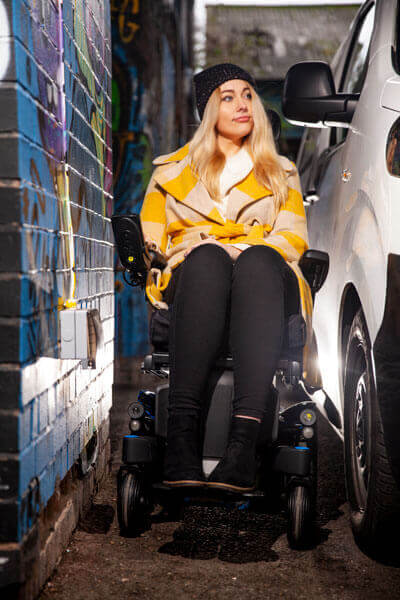When the first mid wheel drive (MWD) power wheelchair (PWC) was made available to wheelchair users, it revolutionized the world of power mobility. I can still recall the first in-service I attended on a MWD PWC back in 2001 while working with pediatric clients in Washington, D.C. At that time, the MWD technology was still relatively new. My clients typically lived in small row homes or apartment buildings with tiny elevators where turning radius and maneuverability were essential. Providing a PWC option with a small turning radius and more intuitive drive allowed for more individuals to seriously consider power mobility as an option for independent mobility.
By no means did the creation of MWD PWCs eliminate the need for rear wheel drive (RWD) or front wheel drive (FWD) PWCs, but it did shift a great deal of the focus of selecting the ideal PWC for a client to the drive wheel position. Healthy discussions began to emerge among clinicians, researchers, complex rehabilitation technology (CRT) providers, and wheelchair manufacturers as to which drive wheel configuration would work best for individuals who utilize PWCs. To learn more about drive wheel position, be sure to check out our Power Wheelchair Drive Wheel Position resource. You can even print out a copy for yourself or to share with others.
In the decades since the first MWD PWCs were launched, numerous technological advances have been created. The options in MWD PWCs have moved the discussion about which PWC base would be ideal for a client far beyond the position of the drive wheel. Three primary examples of these advances in the QUICKIE® MWD PWC portfolio include the revolutionary SpiderTrac® 2.0 suspension, C-Me® seat elevation, and the Q700-UP M power wheelchair with power standing.
Even with all of these amazing technological advances, many people continue to be drawn to MWD PWC bases for the following reasons: an intuitive driving experience for the user, the ability to drive and maneuver around smaller spaces, and an overall more compact package. With all of the options available on MWD PWCs, it is important to read the fine print and understand what the specifications mean to ensure the user is getting what he truly needs.
Let's take a look at some numbers related to PWCs you should pay close attention to when helping to identify the most appropriate MWD PWC for a client:
Dimensions
Size does matter, especially when an individual is navigating his PWC through various environments such as home, work, stores, elevators, physicians' offices, vehicles, restaurants, public restrooms, etc. While it is absolutely impossible to predict everywhere a client will take his PWC throughout the life of the chair, knowing the dimensions of the key areas (i.e. home, personal vehicle, and work/school) and the overall width & length of the PWC is vital. I've been told there are few things more frustrating than having a PWC that is half an inch too wide to get through the doorway of your home bathroom.

Turning Radius
The turning radius is the distance from the center of the wheelchair between the two drive wheels, out to the furthest point on the wheelchair base. Turning radius is important to know because it will have a significant impact on maneuvering the PWC in and around small spaces. Remember how I mentioned the frustration of barely not fitting through a bathroom doorway? Well, I've also been told getting into a small space in a PWC is only half the battle. The inability to turn around and/or get out of the small space once you are in it is even more frustrating. With that said, be sure to know the amount of space a PWC requires for turning (aka the turning radius).
Providing the client the opportunity to drive a demo of the PWCs the team is considering in those key areas to ensure he is comfortable and successful with driving the PWC is the best case scenario. However, due to various reasons, the best case scenario might not be possible. If this is the case, consider taking the measurements the CRT provider took during the home evaluation to simulate the home environment by creating a course in which the client has to drive the PWCs through in the wheelchair clinic.
In addition, you should always maximize the use of manufacturer resources such as brochures, websites, your local account manager, or customer service. Dimensions and turning radius are only a piece of the puzzle when it comes to selecting the best PWC base for your clients. By using the tools provided by a manufacturer such as Sunrise Medical, you will be able to not only compare the fine print details such as dimensions, but also see what other important features related to seating, driving, function, etc. are available on a specific PWC base.
Thank you for reading our blog! We love hearing from you, so please do not hesitate to reach out to us. We encourage you to leave a comment below.
Always remember at the end of the day, your client is your number one priority!
- Angie
Follow Angie on Twitter @ATigerKiger